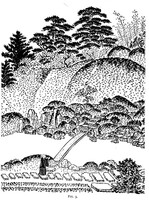The style called Tamatsukuri, or "Ball Treatment," consists in clipping the short twigs and fasciculated leaves into the shape of a number of discs or flattened spheres. Another favourite manner is known by the name of the Fuse-tsukuri, or "Fraying Treatment," by which the different stems are extended along numerous horizontal strips of bamboo, so that the pine needles arrange themselves in radiating lines and ridges. There is still another treatment called the Korin style, after a noted painter of that name, and supposed to be in imitation of his peculiar mannerism in delineating the pine tree. This method shows the branches trained in a pendent arched form, suggestive of the curves of a cascade.
In dressing low garden shrubs, they are generally clipped into hemispherical forms, presenting rounded masses of varying shades of green upon the hill-sides, and between rocks and monuments, and classed under the native term of Marumono, or "Round Material." Different kinds of junipers, box bushes, azalea bushes, and dwarf Thuya obtusï¾µ, are the most common shrubs treated in this manner. Such spherical masses are frequently arranged in clumps on sloping ground, towering one above the other, so as to give the appearance of green hills. This art was carried to perfection in some of the ancient temple gardens, of which Fig. 3 is an example, taken from the grounds of the Banto-In, a monastery in Kioto.

